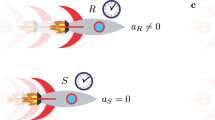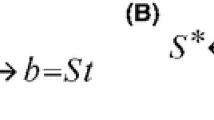Abstract
In the classical Stueckelberg-Horwitz-Piron relativistic Hamiltonian mechanics, a significant aspect of evolution of the classical n-body particle system with mutual interaction is the method by which events along distinct particle world lines are put into correspondence as a dynamical state. Approaches to this procedure are discussed in connection with active and passive symmetry principles.
Similar content being viewed by others
References
E. C. G. Stueckelberg,Helv. Phys. Acta 14, 372, 588 (1941);15, 23 (1942); the invariant time was also discussed by V. A. Fock,Phys. Z. Sowjetunion 12, 404 (1937).
L. P. Horwitz and C. Piron,Helv. Phys. Acta 46, 316 (1973); see also J. R. Fanchi,Parameterized Relativistic Quantum Theory (Kluwer Academic, Dordrecht, 1993),Phys. Rev. D 20, 3108 (1979).
L. P. Horwitz, W. C. Schieve, and C. Piron,Ann. Phys. (New York) 137, 306 (1981). This statistical mechanics predicts specific heats for certain ultrarelativistic systems which differ from the predictions of F. Juttner,Ann. Phys. (Leipzig) 34, 856 (1911) and W. Pauli,The Theory of Relativity (Pergamon, London, 1958), primarily based on his previous article inEncyl. Math. Wiss., Vol. V19 (Teubner, Leipzig, 1921).
L. P. Horwitz, S. Shashoua, and W. C. Schieve,Physica A 161, 299 (1989).
L. Burakowsky, L. P. Horwitz, and W. C. Schieve,Phys. Rev. D 54, 4029 (1996).
R. Balescu, in1964 Cargese Summer School (Gordon & Breach, New York, 1965); I. Prigogine, inStatistical Mechanics of Equilibrium and Non-Equilibrium, J. Meixner, ed. (North-Holland, Amsterdam, 1965); A. Mangeney,Ann. Phys. (Paris) 10, 191 (1965).
R. P. Feynmann,Phys. Rev. 80, 440 (1950).
L. P. Horwitz, R. I. Arshansky, and A. C. Elitzur,Found. Phys. 18, 1159 (1988).
A. O. Barut,Electrodynamics and Classical Theory of Fields and Particles (Macmillan, New York, 1964; Dover, 2nd edn., 1980).
J. D. Jackson,Classical Electrodynamics, 2nd edn. (Wiley, New York, 1975).
W. Israel and H. Kandrup,Ann. Phys. (New York) 152, 30 (1984).
As opposed to theframe dilationγ i=dt/ds.
R. Arshansky, L. P. Horwitz, and Y. Lavie,Found. Phys. 13, 1167 (1983).
D. G. Currie,J. Math. Phys. 4, 1470 (1963).
D. G. Currie, T. Jordan, and E. C. G. Sudarshan,Rev. Mod. Phys. 35, 350 (1963).
P. A. M. Dirac,Rev. Mod. Phys. 21, 335 (1949); see also R. Bakmajian and L. H. Thomas,Phys. Rev. 92, 1300 (1953).
R. Balescu and T. Kotera,Physica 33, 558 (1967); R. Balescu, T. Kotera, and E. Pina,Physica 33, 581 (1967); E. Pina and R. Balescu,Acta Phys. Austriaca 28, 309 (1968).
P. Havas, inStatistical Mechanics of Equilibrium and Non-Equilibrium J. Meixner ed. (North-Holland, Amsterdam, 1965); the problem of manifest covariance in statistical mechanics is discussed by R. Hakim,J. Math. Phys. 8, 1315 (1967);
M. Lipshutz,Theory and Problems of Differential Geometry (McGraw-Hill, New York, 1969).
M. Trump and W. C. Schieve, preprint.
A. Einstein,Bull. Am. Math Soc., April 1935, p. 223.
F. Rohrlich,Phys. Rev. D 23, 1305 (1981); L. P. Horwitz and F. Rohrlich,Phys. Rev. D 24, 1528 (1981); see alsoRelativistic Action-at-a-Distance: Classical and Quantum Aspects, Lecture Notes in Physics, Vol. 162, ed. J. Llosa (Springer, Berlin, 1982);Proceedings of the Workshop on Constraint's Theory and Relativistic Dynamics, Arceti, Firenze, 1986, eds. G. Longhi and L. Lussanna (World Scientific, Singapore, 1987).
L. P. Horwitz,Found Phys. 22, 421 (1992) (invited paper, Karl Popper issues).
J. Synge,Relativity: The Special Theory (Interscience, New York, 1956); attempts to reconcile field theory with global causality lead to paradoxes in closed systems (see L. H. Thomas,Phys. Rev. 85, 868 (1952) and Ref. 14 p. 1473 on the “Shadow of Interference”); radiative reaction requires inclusion of both the retarded andadvanced light cone fields, J. A. Wheeler and R. P. Feynman,Rev. Mod. Phys. 17, 157 (1945).
W. C. Schieve and L. P. Horwitz,Phys. Lett. A,156, 140 (1991); L. P. Horwitz and W. C. Schieve,Phys. Rev. A 46, 743 (1992).
V. I. Arnold,Mathematical Methods of Classical Mechanics (Springer, New York, 1978).
H. Goldstein,Classical Mechanics (Addison-Wesley, Reading, Massachusetts, 2nd edn., 1980).
B. F. Schutz,A First Course in General Relativity (Cambridge University Press, Cambridge, 1990).
Author information
Authors and Affiliations
Rights and permissions
About this article
Cite this article
Trump, M., Schieve, W.C. The synchronization problem in covariant relativistic dynamics. Found Phys 27, 1–17 (1997). https://doi.org/10.1007/BF02550152
Received:
Issue Date:
DOI: https://doi.org/10.1007/BF02550152




